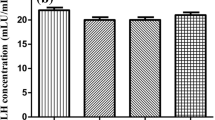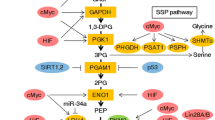Abstract
A substantial literature supports the notion that cancer is a metabolic disease. Mitochondria are sexually dimorphic, and progesterone (P4) plays a key regulatory role in mitochondrial functions. We investigated the effect of P4 on mitochondrial functions in three human glioblastoma multiforme (GBM) cell lines. In dose–response and time–response studies, GBM cells were exposed to different concentrations of P4 followed by mitochondrial stress-testing with a Seahorse analyzer. Data were analyzed for oxygen consumption rate (OCR), extracellular acidification rate (ECAR), and spare respiratory capacity (SRC) to determine the effects of P4 exposure on mitochondrial respiration and rate of glycolysis. We also examined the effect of P4 on mitochondrial superoxide radical generation by confocal microscopy. As early as 1h post-P4 exposure, we found a substantial dose-dependent inhibitory effect of P4 on OCR, ECAR, and SRC in all GBM cell lines. P4 treatment altered the levels of basal respiration, maximum respiration, nonmitochondrial oxygen consumption, ATP production, and proton leak. P4 given at 80-μM concentration showed the maximum inhibitory effect compared to controls. Live imaging data showed an 11–22% increase in superoxide radical generation in all three GBM cell lines following 6h exposure to a high concentration of P4. Our data show that high-dose P4 exerts an inhibitory effect on both mitochondrial respiration and glycolysis in GBM cells. These effects would lead to decreased tumor size and rate of growth, representing a potential treatment to control the spread of GBM.








Similar content being viewed by others
Data Availability
All the data, meterials, and methods are reported in the manuscript.
References
Skoda J, Borankova K, Jansson PJ, Huang M, Veselska R, Richardson DR (2019) Pharmacological targeting of mitochondria in cancer stem cells: an ancient organelle at the crossroad of novel anti-cancer therapies. Pharmacol Res 139:298–313
Caino MC, Altieri DC (2016) Molecular pathways: mitochondrial reprogramming in tumor progression and therapy. Clin Cancer Res 22(3):540–545
Seyfried TN, Flores R, Poff AM, D'Agostino DP, Mukherjee P (2015) Metabolic therapy: a new paradigm for managing malignant brain cancer. Cancer Lett 356(2 Pt A):289–300
Chinopoulos C, Seyfried TN (2018) Mitochondrial substrate-level phosphorylation as energy source for glioblastoma: review and hypothesis. ASN Neuro 10:1759091418818261
Gaignard P, Fréchou M, Liere P, Thérond P, Schumacher M, Slama A, Guennoun R (2018) Sex differences in brain mitochondrial metabolism: influence of endogenous steroids and stroke. J Neuroendocrinol 30(2)
Ghoumari AM, Abi Ghanem C, Asbelaoui N, Schumacher M, Hussain R (2020) Roles of progesterone, testosterone and their nuclear receptors in central nervous system myelination and remyelination. Int J Mol Sci 21(9):3163
Guennoun R, Zhu X, Fréchou M, Gaignard P, Slama A, Liere P, Schumacher M (2019) Steroids in stroke with special reference to progesterone. Cell Mol Neurobiol 39(4):551–568
Guennoun R (2020) Progesterone in the brain: hormone, neurosteroid and neuroprotectant. Int J Mol Sci 21(15):5271
Atif F, Yousuf S, Espinosa-Garcia C, Sergeeva E, Stein DG (2019) Progesterone treatment attenuates glycolytic metabolism and induces senescence in glioblastoma. Sci Rep 9(1):988
Atif F, Yousuf S, Stein DG (2015a) Anti-tumor effects of progesterone in human glioblastoma multiforme: role of PI3K/Akt/mTOR signaling. J Steroid Biochem Mol Biol 146:62–73
Atif F, Patel NR, Yousuf S, Stein DG (2015b) The synergistic effect of combination progesterone and temozolomide on human glioblastoma cells. PLoS One 10:e0131441
Wu NY, Huang HS, Chao TH, Chou HM, Fang C, Qin CZ, Lin CY, Chu TY et al (2017) Progesterone prevents high-grade serous ovarian cancer by inducing necroptosis of p53-defective fallopian tube epithelial cells. Cell Rep 18:2557–2565
Bu SZ, Yin DL, Ren XH, Jiang LZ, Wu ZJ, Gao QR, Pei G (1997) Progesterone induces apoptosis and up-regulation of p53 expression in human ovarian car- cinoma cell lines. Cancer. 79:1944–1950
Formby B, Wiley TS (1999) Bcl-2, survivin and variant CD44 v7-v10 are downregu- lated and p53 is upregulated in breast cancer cells by progesterone: inhibition of cell growth and induction of apoptosis. Mol Cell Biochem 202:53–61
Horita K, Inase N, Miyake S, Formby B, Toyoda H, Yoshizawa Y (2001) Progesterone induces apoptosis in malignant mesothelioma cells. Anticancer Res 21:3871–3874
Medina D, Kittrell FS, Tsimelzon A, Fuqua SA (2007) Inhibition of mammary tumorigenesis by estrogen and progesterone in genetically engineered mice. Ernst Schering Foundation Symposium Proceedings:109–126
Altinoz MA, Ucal Y, Yilmaz MC, Kiris İ, Ozisik O, Sezerman U, Ozpinar A, Elmaci I (2020) Progesterone at high doses reduces the growth of U87 and A172 glioblastomacells: proteomic changes regarding metabolism and immunity. Cancer Med 9(16):5767–5780
Andrabi SS, Parvez S, Tabassum H (2017) Progesterone induces neuroprotection following reperfusion-promoted mitochondrial dysfunction after focal cerebral ischemia in rats. Dis Model Mech 10(6):787–796
Gaignard P, Fréchou M, Schumacher M, Thérond P, Mattern C, Slama A, Guennoun R (2016) Progesterone reduces brain mitochondrial dysfunction after transient focal ischemia in male and female mice. J Cereb Blood Flow Metab 36(3):562–568
Robertson CL, Saraswati M (2015) Progesterone protects mitochondrial function in a rat model of pediatric traumatic brain injury. J Bioenerg Biomembr 47(1-2):43–51
Price TM, Dai Q (2015) The Role of a Mitochondrial progesterone receptor (PR-M) in progesterone action. Semin Reprod Med 33(3):185–194
Wasserstein RL, Lazar NA (2016) Editorial. Am Stat 70:129–133
Wasserstein RL, Schirm AL, Lazar NA (2019) Moving to a world beyond "p<0.05". Am Stat 73:1–19
Strom JO, Theodorsson A, Theodorsson E (2011) Hormesis and female sex hormones. Pharmaceuticals (Basel) 4(5):726–740
Atif F, Patel NR, Yousuf S, Stein DG (2015) The synergistic effect of combination progesterone and temozolomide on human glioblastoma cells. PLoS One 10(6):e0131441
Liu P, Cheng H, Roberts TM, Zhao JJ (2009) Targeting the phosphoinositide 3-kinase pathway in cancer. Nat Rev Drug Discov 8:627–644
Behera MA, Dai Q, Garde R, Saner C, Jungheim E, Price TM (2009) Progesterone stimulates mitochondrial activity with subsequent inhibition of apoptosis in MCF-10A benign breast epithelial cells. Am J Physiol Endocrinol Metab 297(5):E1089–E1096
Dai Q, Likes CE, Luz AL, Mao L, Yeh JS, Wei Z, Kuchibhatla M, Ilkayeva OR et al (2019) A mitochondrial progesterone receptor increases cardiac beta-oxidation and remodeling. Endocr Soc 3(2):446–467
Dai Q, Provost MP, Raburn DJ, Price TM (2020) Progesterone increases mitochondria membrane potential in non-human primate oocytes and embryos. Reprod Sci 27(5):1206–1214
Krebs CJ, Jarvis ED, Chan J, Lydon JP, Ogawa S, Pfaff DW (2000) A membrane-associated progesterone-binding protein, 25-Dx, is regulated by progesterone in brain regions involved in female reproductive be- haviors. Proc Natl Acad Sci USA 97:12816–12821
Xu J, Zeng C, Chu W, Pan F, Rothfuss JM, Zhang F, Tu Z, Zhou D et al (2011) Identification of the PGRMC1 protein complex as the putative sigma-2 receptor binding site. Nat Commun 2:380
Piel RB, Shiferaw MT, Vashisht AA, Marcero JR, Praissman JL, Phillips JD, Wohlschlegel JA, Medlock AE (2016) A novel role for progesterone receptor membrane component 1 (PGRMC1): a partner and regulator of ferrochelatase. Biochem. 55(37):5204–5217
Terzaghi Luciano AM, Dall’Acqua PC, Modina SC, Peluso JJ, Lodde V (2018) PGRMC1 localization and putative function in the nucleolus of bovine granulosa cells and oocytes. Reproduction. 155(3):273–282
Thejer BM, Adhikary PP, Kaur A, Teakel SL, van Oosterum A, Seth I, Pajic M, Hannan KM et al (2020) PGRMC1 phosphorylation affects cell shape, motility, glycolysis, mitochondrial form and function, and tumor growth. BMC Mol Cell Biol 21:24
Strickaert A, Saiselet M, Dom G, De Deken X, Dumont JE, Feron O, Sonveaux P, Maenhaut C (2017) Cancer heterogeneity is not compatible with oneunique cancer cell metabolic map. Oncogene. 36(19):2637–2642
Marin-Valencia I, Yang C, Mashimo T, Cho S, Baek H, Yang XL, Rajagopalan KN, Maddie M et al (2012) Analysis of tumor metabolism reveals mitochondrial glucose oxidation in genetically diverse human glioblastomas in the mouse brain in vivo. Cell Metab 15(6):827–837
Khalifa ARM, Abdel-Rahman EA, Mahmoud AM, Ali MH, Noureldin M, Saber SH, Mohsen M, Ali SS (2017) Sex-specific differences in mitochondria biogenesis, morphology, respiratory function, and ROS homeostasis in young mouse heart and brain. Phys Rep 5(6):e13125
Acknowledgements
The authors thank Leslie McCann for invaluable editorial assistance. FA is thankful to Dr. Victor Faundez and Dr. Stephanie Zlatic, Department of Cell Biology, Emory University for providing Seahorse Analyzer training.
Funding
This research was supported in part by gifts obtained by Dr. Stein from Allen and Company and The Marcus Foundation.
Author information
Authors and Affiliations
Contributions
FA, SY: conceived, designed, and performed the experiments; CEG: performed the experiments; FA, DGS: analyzed the data; FA: wrote the initial version of the manuscript; and DGS: edited the manuscript.
Corresponding author
Ethics declarations
Ethics Approval
The use of human glioblastoma cell lines in this study was approved by the Institutional Animal Care and Use Committee, Emory University, Atlanta, GA, USA.
Consent for Publication
All the authors have given consent to publish this study.
Competing Interests
A US patent (# US 8,435,972 B2) was issued to FA and DGS on May 7, 2013, for the use of P4 and compositions related thereto for the treatment of neurogenic tumors specially neuroblastoma and glioblastoma. At present, there are no commercial or financial claims related to the patent. Allen and Company is an investment firm with no commercial interests in pharmacology or any other matter relating to our research. The Marcus Foundation is a philanthropic foundation supporting research in developmental psychobiology and other related areas. The funders had no role in study design, data collection and analysis, decision to publish, or preparation of the manuscript.
Additional information
Publisher’s Note
Springer Nature remains neutral with regard to jurisdictional claims in published maps and institutional affiliations.
Rights and permissions
About this article
Cite this article
Atif, F., Yousuf, S., Espinosa-Garcia, C. et al. Progesterone Modulates Mitochondrial Functions in Human Glioblastoma Cells. Mol Neurobiol 58, 3805–3816 (2021). https://doi.org/10.1007/s12035-021-02382-1
Received:
Accepted:
Published:
Issue Date:
DOI: https://doi.org/10.1007/s12035-021-02382-1




